Harvesting fresh basil from your garden is a joyous experience, but picking it at the perfect time is crucial to maximize its flavor. In this master guide, I will share with you the tips and techniques to help you determine the ideal moment to harvest your basil leaves.
Regular harvesting and pruning are essential for all types of basil. Whether you grow basil in containers or in your garden, regular harvesting or pruning promotes healthy plants and abundant harvests. By understanding when and how to pick basil, you can enjoy a constant supply of this fragrant herb throughout the season.
Pinching back the main stem is a key technique for promoting growth in basil. By pinching back the main stem shortly after transplanting, you encourage the plant to produce side shoots, resulting in a bushier plant and increased abundance. This method, similar to deadheading in the flower world, can be repeated throughout the season to promote continuous growth and harvest.
Key Takeaways:
- Regular harvesting and pruning promote healthy basil plants and abundant harvests.
- Pinching back the main stem encourages side shoots and bushy growth.
- Environmental factors can induce stress in basil plants, leading to the production of flowers for seeding.
- Harvest basil leaves when the plant has 4-6 sets of true leaves and starts to bush out.
- Sufficient airflow is crucial for preventing fungal diseases and stress in basil plants.
- Harvest basil at different stages of growth using specific techniques.
- Proper preservation techniques, such as drying and freezing, ensure a continuous supply of basil.
- Frequently asked questions about harvesting basil are addressed to provide clarity.
Regular Harvesting or Pruning is Essential for All Types of Basil
When it comes to growing basil, regular harvesting or pruning is crucial for maintaining healthy plants and ensuring abundant harvests. Whether you’re growing basil in containers or in your garden, the terms “harvest” and “prune” can be used interchangeably when it comes to basil. By properly harvesting and pruning your basil plants, you can promote maximum growth and enjoy a continuous supply of this flavorful herb.
There are several reasons why regular harvesting is important for basil:
- Pinching back the main stem promotes side shoots: To encourage bushy growth, pinch back the main stems about ¼ inch above the first set of true leaves shortly after transplanting. This process stimulates the plant to produce side shoots, resulting in a fuller and more abundant basil plant. By repeating this method throughout the season, cutting about ¼ inch above a growing node, you can continually promote new growth.
| Tip: | Pinch back the main stem to encourage side shoots and bushy growth. |
|---|
- Basil’s sensitivity to environmental factors: Basil is highly sensitive to environmental factors such as drought, cold temperatures, and heavy rainfall. These events can stress the plant and cause it to “bolt,” or produce flowers for seeding. To prevent this, regularly inspect your basil plants for signs of stress, such as leggy growth or the presence of flowers in the center. Pinch off any flowers to redirect the plant’s energy towards leaf production.
| Tip: | Regularly check for flowers and pinch them off to prevent your basil from going to seed. |
|---|
- Basil plants should have 4-6 sets of true leaves before harvesting: When harvesting basil leaves for consumption, it’s important to wait until the plant has developed 4-6 sets of true leaves. This ensures that the plant is mature enough to handle harvesting without stunting its growth. By harvesting regularly, you can encourage continued leaf growth and ensure a steady supply of fresh basil.
“Basil plants should have 4-6 sets of true leaves before intentionally harvesting leaves for consumption.”
- Ensure sufficient airflow for healthy basil plants: Proper airflow is essential for preventing fungal diseases and reducing stress in basil plants. If you have intercropped basil with other crops, such as tomatoes, make sure there is enough space between plants to allow for adequate airflow. You can also use a fan in a protected area, like a greenhouse, to promote better airflow and prevent disease.
| Tip: | Provide sufficient spacing between basil plants or use a fan to promote airflow. |
|---|
By regularly harvesting or pruning your basil plants, you can encourage healthy growth, prevent the plant from going to seed prematurely, and enjoy a bountiful supply of fresh basil throughout the season.
Techniques for Pruning Basil to Promote Growth
Pinching back the main stem will prompt your plant to produce side shoots. To encourage side shoots and bushy growth, pinch back the main stems about ¼ inch above the first set of true leaves on the main stem shortly after transplanting. You can take a few leaves from the side to enjoy if the plant seems able to withstand the pruning at that time. Pinching back the main stem will encourage your plant to send out side shoots, creating a nice bushy plant and more abundance.
Pro tip: You’ve doubled your basil growth just by making one cut, and it will soon be sending out more side shoots after each time you harvest and prune.
This is the same process when growing snapdragons or zinnias; pinching back the first bloom encourages side shoots. In the flower world, it is also called “deadheading.” Continue with pruning every week or so to keep the growth going.
You’ll notice side shoots growing off the node you cut above soon after pinching back your plant. This is great! You’ve doubled your basil growth just by making one cut, and it will soon be sending out more side shoots after each time you harvest and prune. Continue repeating this method throughout the season by cutting about ¼ inch above a growing node.
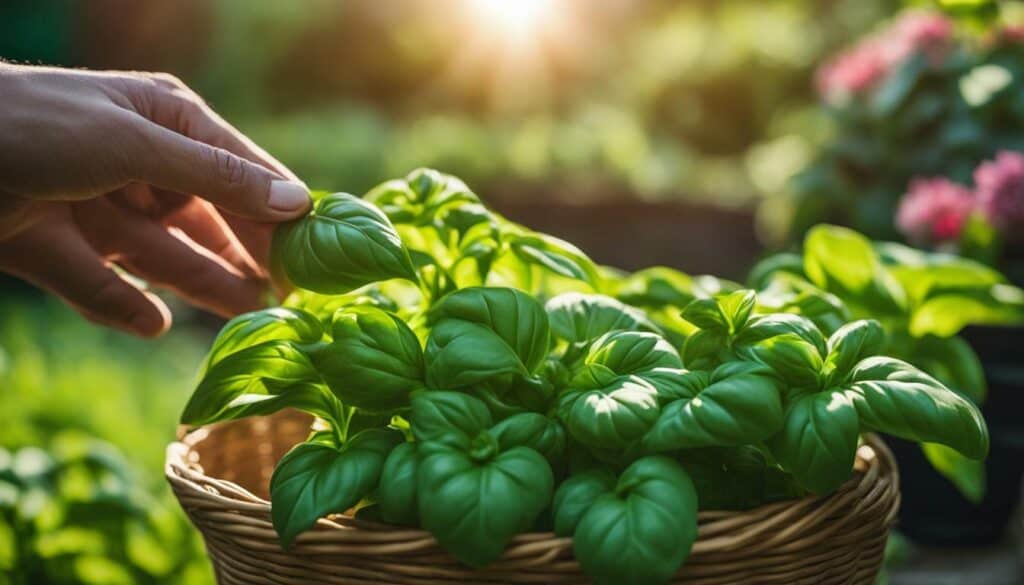
Propagating basil from cuttings
Most varieties take an average of 60-70 days to mature, but if you want to try your hand at succession planting basil and want a head start, try placing the stem tips you pruned off, also known as cuttings, into clean water for a few weeks or until they form roots.
They can then be transplanted into a container or your garden plot, and voila, you have young, cloned basil plants!
- Pro tip: Snipping above a node stimulates lateral growth and leads to a doubled production.
Even if you don’t need the basil immediately, consistently harvest or prune every week to encourage it to spend its energy growing leaves instead of going to seed. You are communicating to your plant: “You are needed! Please continue providing me with delicious basil!”
If you find yourself with a large harvest but no immediate need, you can share it with a friend, add it to a rustic wildflower bouquet, or preserve it for later.
Pro tip: Snipping above a node stimulates lateral growth and leads to a doubled production.
The Importance of Regular Harvesting and Pruning
When it comes to growing basil, regular harvesting and pruning are essential for healthy plants and abundant harvests. Whether you are growing basil in containers or in your garden, these practices promote growth and ensure a continuous supply of fresh basil leaves. By understanding the importance of regular harvesting and pruning, you can maximize the flavor and productivity of your basil plants.
One of the main benefits of regular harvesting and pruning is that it encourages bushy growth and side shoots. By pinching back the main stem about ¼ inch above the first set of true leaves, you can stimulate your basil plant to produce side shoots. This technique is similar to pinching back the blooms of flowers like snapdragons or zinnias, which promotes the growth of side shoots. By regularly pruning your basil plant, you can achieve a bushy and abundant plant that provides you with a continuous supply of basil leaves.
Another advantage of regular harvesting and pruning is that it prevents basil plants from bolting and going to seed. Basil is sensitive to environmental factors such as drought, cold temperatures, and heavy rainfall. These stressors can cause the plant to bolt, which means it produces flowers for seeding instead of continuing to produce leaves. When basil plants bolt, the flavor of the leaves becomes bitter, and the plants stop producing leaves altogether. By regularly checking your basil plants for signs of stress and removing any flowers that are starting to bud, you can prevent bolting and maintain a continuous supply of fresh basil leaves.
It’s important to note that when harvesting basil leaves for consumption, you should wait until the plants have 4-6 sets of true leaves and have started to bush out. This ensures that the plants are mature enough to handle regular harvesting without being depleted. By harvesting basil leaves at the right time and using proper pruning techniques, you can ensure a bountiful supply of basil throughout the growing season.
Adequate airflow is crucial for the health of basil plants, especially when intercropped with other plants. Proper airflow helps prevent fungal diseases and stress, ensuring that your basil plants remain healthy and productive. If you are growing basil in a protected area like a greenhouse, you can also use a fan to improve airflow and reduce the risk of disease.
In conclusion, regular harvesting and pruning are crucial for the successful growth of basil. By practicing these techniques, you can encourage bushy growth, prevent bolting, and maintain a continuous supply of fresh basil leaves. Remember to harvest basil at the right stage of growth, ensure sufficient airflow, and pay attention to environmental factors that can induce stress in the plants. With these tips, you can enjoy a bumper crop of flavorful basil all season long.
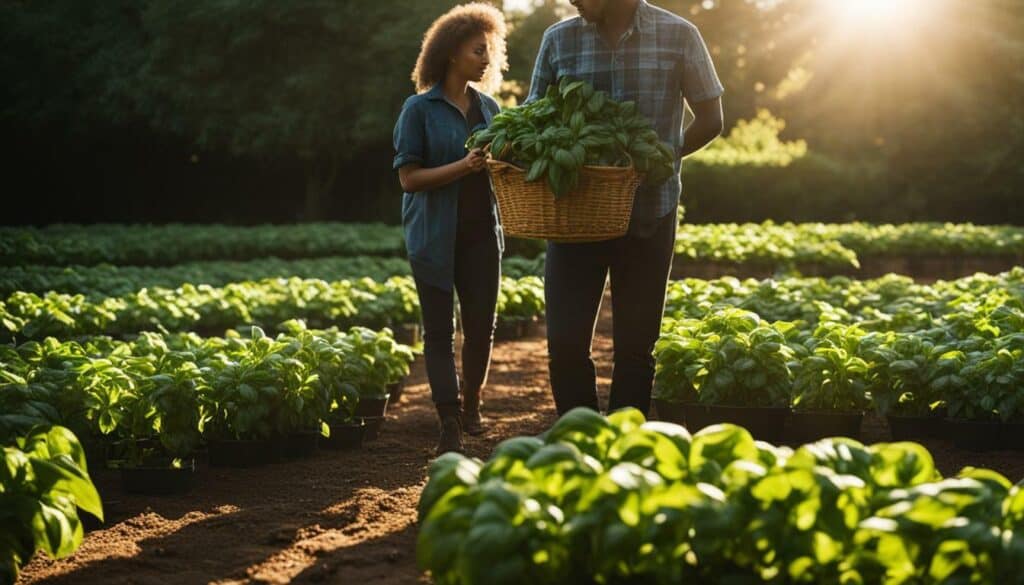
Harvesting Basil Leaves for Consumption
Basil plants should have 4-6 sets of true leaves and start to bush out before you intentionally harvest leaves for consumption. At this stage, the plant is mature enough to handle regular harvesting without causing damage.
To start the process, find a stem that has grown at least 4-6 sets of leaves. Using a sharp pair of scissors or garden shears, make a clean cut just above a set of leaves, leaving a short piece of stem attached to the leaves. This will promote regrowth and ensure the plant continues to produce more leaves.
When harvesting basil leaves, it’s important to be mindful of the plant’s growth pattern. Always leave at least two sets of true leaves on each stem to allow for continued growth and vitality. Cutting too close to the base of the plant can stunt its growth and diminish its ability to produce more leaves. By leaving a portion of the stem intact, you encourage the plant to redirect its energy into new leaf growth.
| Tips for Harvesting Basil Leaves |
|---|
| Use sharp scissors or garden shears to make clean cuts. |
| Leave at least two sets of true leaves on each stem. |
| Harvest leaves regularly to promote continuous growth. |
| Avoid cutting too close to the base of the plant. |
Regularly harvesting your basil also prevents it from flowering.
By harvesting basil leaves regularly, you not only ensure a fresh supply for your culinary creations but also stimulate the plant to produce more leaves. Basil is resilient and will continue to grow as long as it is properly cared for.
Remember to be mindful of the plant’s needs and not to over-harvest. Taking more leaves than the plant can handle at once can stress the plant and hinder its ability to regrow. A good rule of thumb is to harvest no more than one-third of the plant’s leaves at a time.
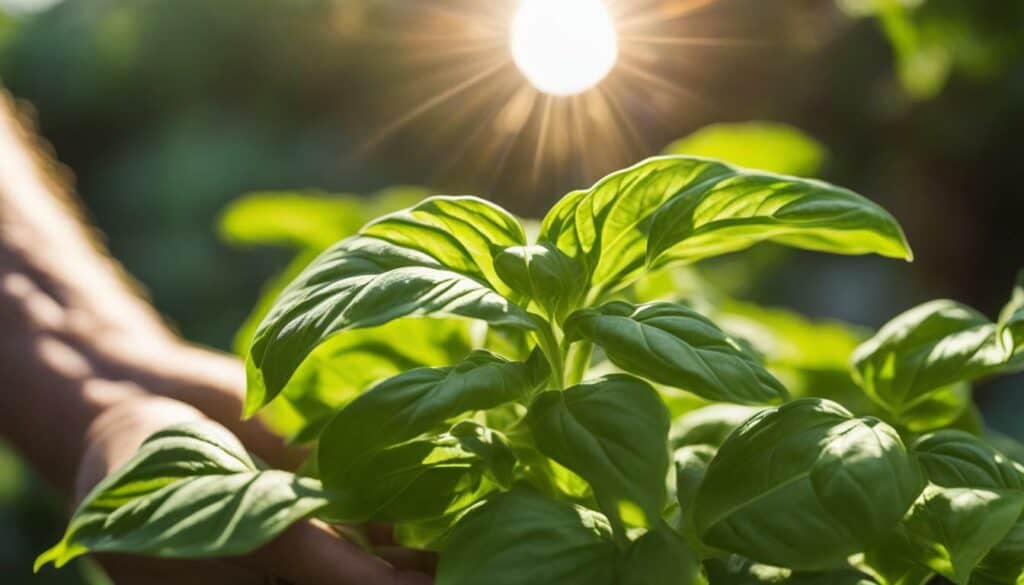
Tips for Harvesting Basil Leaves:
- Use sharp scissors or garden shears to make clean cuts.
- Leave at least two sets of true leaves on each stem.
- Harvest leaves regularly to promote continuous growth.
- Avoid cutting too close to the base of the plant.
When harvesting basil leaves, it’s important to handle them with care to prevent bruising and damage. Basil leaves are delicate and can bruise easily, which can affect their flavor and texture. To minimize bruising, gently handle the leaves and avoid squeezing or pressing them too hard.
Once you have harvested your basil leaves, it’s best to use them as soon as possible to enjoy their fresh flavor. However, if you have excess leaves and want to preserve them for later use, there are several methods you can try. Drying basil leaves is a popular option, as it allows you to extend their shelf life while still retaining their flavor.
- Hang the harvested basil leaves in a cool, dry place to air dry.
- Place the leaves in a dehydrator set to a low temperature.
- Store the dried leaves in an airtight container away from heat and light.
You can also freeze basil leaves to preserve their flavor. To do this, blanch the leaves in boiling water for a few seconds, then transfer them to an ice bath to cool. Once cooled, pat the leaves dry and place them in freezer-safe containers or bags. Frozen basil leaves can be used in cooking without the need for thawing.
Whether you choose to dry or freeze your harvested basil leaves, be sure to label and date the containers for easy reference. This will help you keep track of their freshness and ensure you use them before they lose their flavor.
Ensure sufficient airflow for your growing plant to prevent fungal diseases and stress. Proper airflow is crucial for the health of your basil plants, as it helps to prevent the development of fungal diseases and reduces stress on the plants. This is especially important if you have intercropped your basil with other crops, such as tomatoes. Increased airflow allows the plants to breathe freely and promotes overall plant health.
One effective way to ensure adequate airflow is by spacing your basil plants properly. Give each plant enough room to grow and spread out its leaves without overcrowding. This will allow air to circulate freely around the plants and prevent the buildup of excess moisture, which can lead to fungal diseases.
If you are growing your basil in a protected area, such as a greenhouse or polytunnel, you can further enhance airflow by using fans. Running a fan in your growing space helps to circulate air and reduce humidity, creating a less favorable environment for fungal diseases.
Additionally, regularly inspect your basil plants for signs of pests or diseases. Remove any infected leaves or plants immediately to prevent the spread of disease to neighboring plants.
Pro tip: If you notice that your basil plants are exhibiting signs of stress or disease, such as yellowing leaves or wilting, take immediate action to address the issue. This may involve adjusting watering practices, improving drainage, or applying organic pest control methods.
To summarize, ensuring sufficient airflow is vital for healthy basil plants. By spacing your plants properly, using fans if necessary, and regularly monitoring for pests and diseases, you can create an environment that promotes optimal growth and prevents fungal diseases. Your basil plants will thrive and provide you with an abundant harvest of flavorful leaves.
“Proper airflow is crucial for the health of your basil plants, as it helps to prevent the development of fungal diseases and reduces stress on the plants.”
- Space your basil plants adequately to allow for proper airflow and prevent overcrowding.
- Inspect your plants regularly for signs of pests or diseases, and take immediate action if needed.
- If growing in a protected area, consider using fans to enhance airflow and reduce humidity.
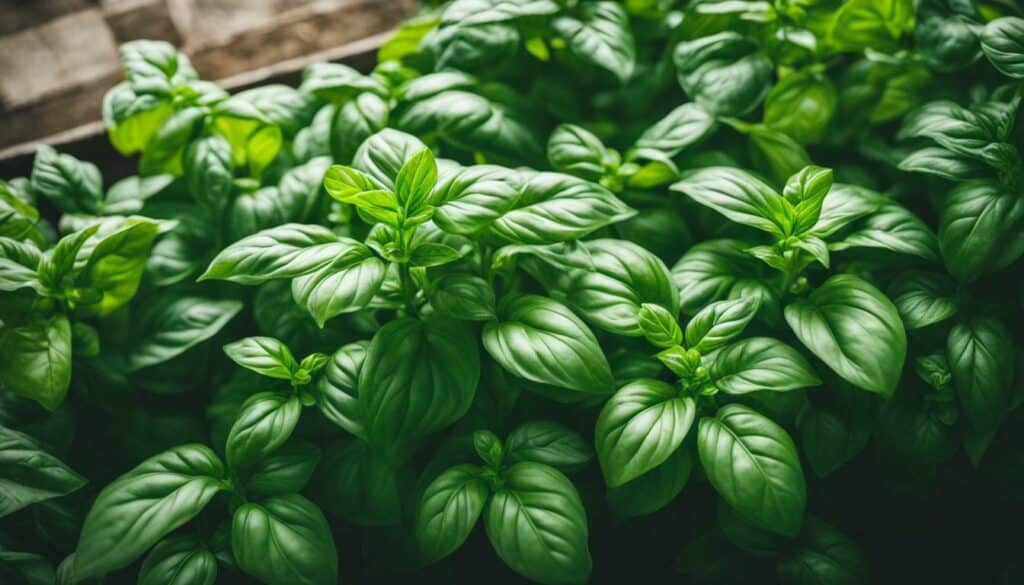
By following these tips, you can ensure your basil plants have sufficient airflow for optimal growth, prevent fungal diseases, and maintain healthy and vibrant plants throughout the growing season. Happy gardening and happy harvesting!
Harvesting Basil at Different Stages of Growth
There are several different harvest windows in the basil lifecycle. The timing of your harvest will depend on the age and size of your basil plants. By understanding when to pick basil at different stages of growth, you can ensure a continuous supply of fresh and flavorful leaves. Here are the specific techniques to use:
1. Harvesting Young Basil Plants
When your basil plants are young and have 4-6 sets of true leaves, you can start harvesting side leaves. Pinching off the top clusters of leaves encourages growth and bushiness. Snip off the side shoots as you did with the main growing tip. Be mindful not to take more than the plant can handle at any given time. Harvesting at this stage will help promote further growth and provide you with an early taste of fresh basil.
2. Harvesting Mature Basil Plants
As your basil plants continue to grow and develop, they will become more robust and leafy. At this stage, you can harvest larger amounts of basil leaves. Snip the stems near the leaf nodes, just above the lowest pair of leaves. This technique promotes regrowth and ensures that your plants continue to produce abundant leaves. Remember to leave at least one-third of the stem intact to allow for further growth.
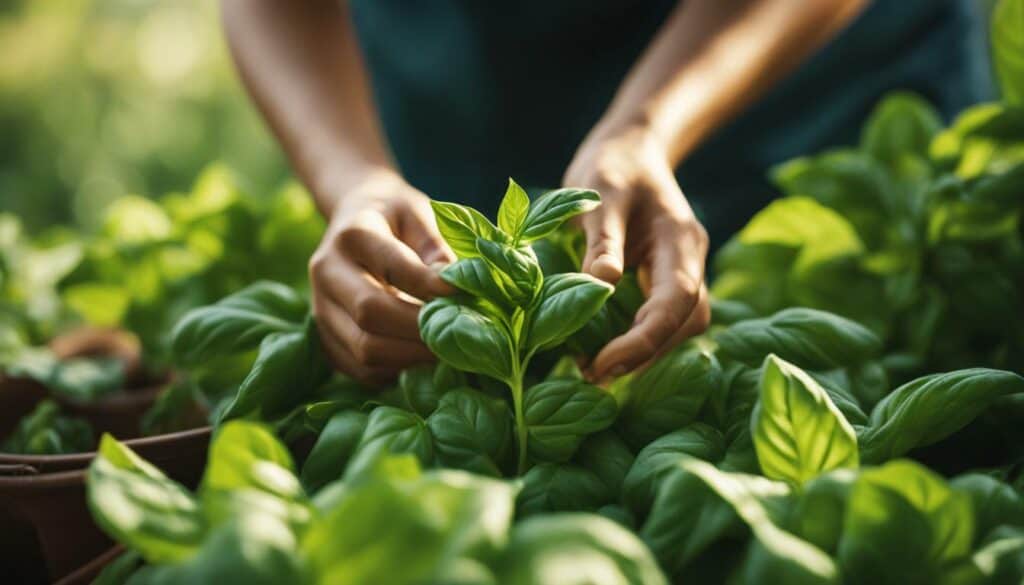
3. Harvesting Basil Flowers
When basil plants start to produce flower buds, it indicates that they are nearing the end of their lifecycle. While the leaves may become smaller and less flavorful, you can still harvest basil flowers. The young flowers are edible and tender, with a milder flavor than the adult plant. Consider using them in salads or infusing vinegar for a unique culinary experience. By harvesting the flowers, you can prolong the plant’s productivity and enjoy its flavors in different forms.
Remember, regular harvesting is key to maintaining healthy basil plants and ensuring a continuous supply of fresh leaves. As you trim and prune your basil, it will respond by growing more vigorously and providing you with an abundance of aromatic and flavorful herbs.
What can you do with leftover basil?
After harvesting your basil, you may find yourself with more leaves than you can use immediately. Fortunately, there are several ways to make the most of your leftover basil and preserve its flavor for later use.
One option is to dry your basil. Air drying is a popular method and requires no specialized equipment. Simply tie small bundles of basil together and hang them upside down in a cool, dry place. After a few weeks, the leaves will be dry and can be crumbled into jars for future use.
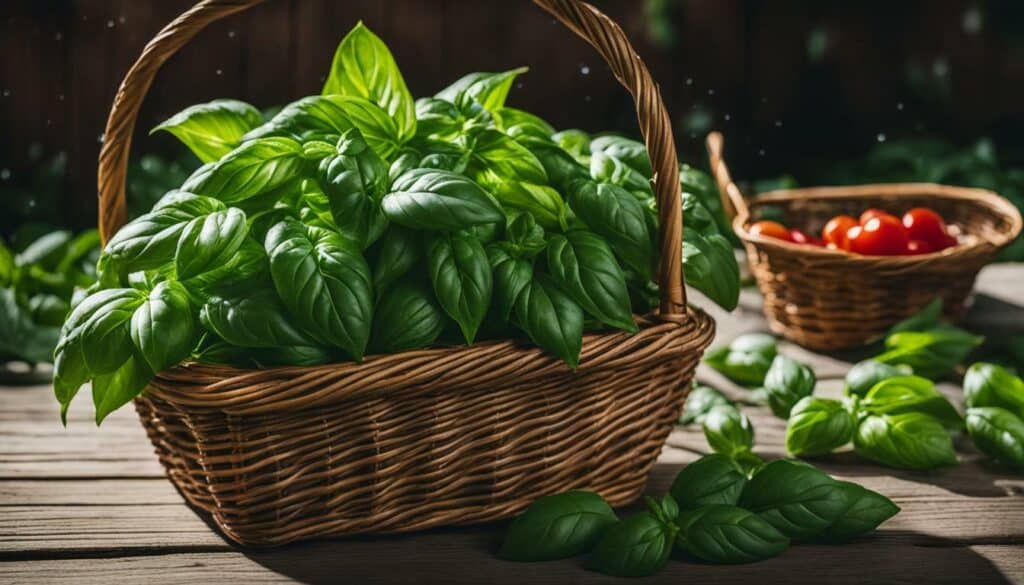
Another option is to freeze your basil. Freezing basil helps retain its vibrant color and flavor. One method is to puree fresh basil leaves with a little olive oil and freeze the mixture in ice cube trays. Once frozen, transfer the cubes to a resealable bag for easy portioning. Frozen basil can be added directly to soups, sauces, and other dishes.
You can also create flavored oils or vinegars with your leftover basil. Simply add a handful of fresh basil leaves to a bottle of oil or vinegar and let it infuse for a few weeks. Strain out the basil leaves and use the infused oils or vinegars in dressings, marinades, and other recipes.
If you’re feeling adventurous, you can even use the basil flowers! The young basil flowers are edible and have a milder flavor than the leaves. They can be tossed in salads or used to make homemade basil-infused vinegars.
Tip: When storing basil, avoid washing it until you’re ready to use it, as moisture can cause it to spoil more quickly. Instead, wrap the basil in a slightly damp paper towel and keep it in the refrigerator.
Can you harvest basil too early?
When it comes to harvesting basil, there is no strict rule on when is too early. Once the leaves are big enough to use, you can start harvesting. In fact, the more often you harvest your basil, the bigger and bushier your plants will get. However, if you have just transplanted your basil seedlings, it’s recommended to give them a few days to acclimate before harvesting heavily. But picking a leaf or two should be fine.
How do you harvest basil so it keeps growing?
To ensure that your basil plants keep growing and producing abundant leaves, there are a few key tips to keep in mind:
- When harvesting, don’t cut more than half the plant off, and try to snip stems near the leaf nodes, where the leaves connect to the stem. This encourages new growth and fuller basil plants.
- Use small snips or scissors to harvest, or simply snap off a stem of basil with a sturdy hand.
- Harvest the new growth off your basil plants every 7-10 days, pruning off the top 2-3 sets of leaves on each stem. This will stimulate side shoots to grow, making the plants bushier and more robust.
- If you need a large amount of basil at once, make sure to leave at least 50% of the plant behind so it can regrow.
Will basil grow back after cutting?
Yes, basil will grow back after cutting, especially if you regularly pinch off as much as you need at a time. This encourages more robust growth and fuller basil plants. However, make sure not to cut more than half the plant off, as this may limit its chances of regrowing. By harvesting frequently, you can enjoy a continuous supply of fresh basil throughout the growing season.
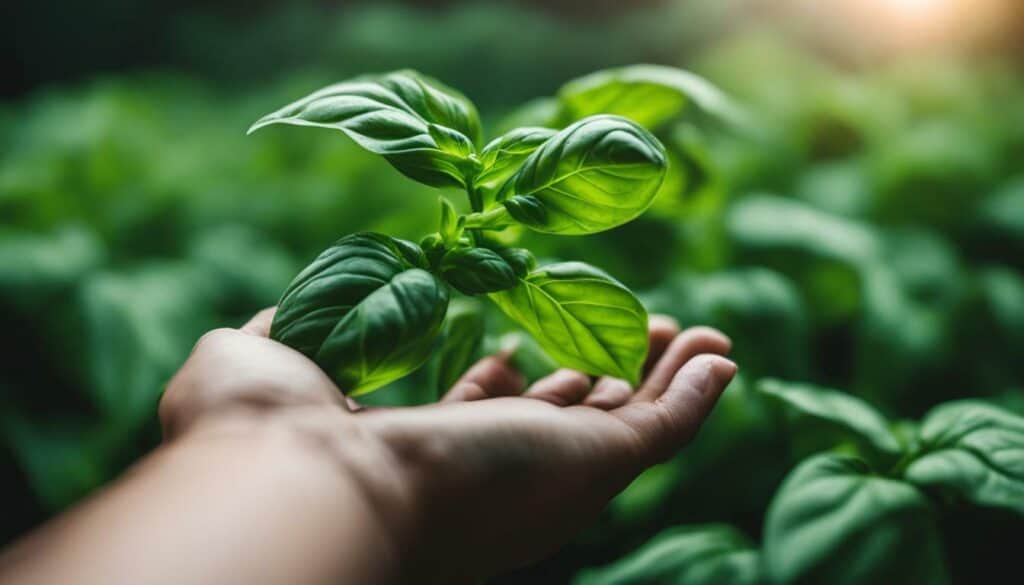
How often should you harvest basil?
The frequency of harvesting basil can vary depending on your needs and the size of your plant. Most families can get by with harvesting from one or two basil plants as often as they need it for regular at-home cooking. As a general guideline, try to clip or pinch off the top of each stem every 7-10 days during the summer. This regular harvesting will help promote continuous growth and ensure a bountiful supply of basil leaves.
Can you harvest basil after flowering?
Yes, you can still harvest basil even after it starts flowering. However, once a basil plant begins to produce flower buds, it diverts its energy into flowering and producing seeds, resulting in smaller, paler leaves with less flavor. By continuing to harvest during the flowering stage, you can delay the plant’s flowering process and encourage new leaf growth. So don’t hesitate to harvest your basil, even if it has started to flower!
“Harvesting basil frequently prevents it from flowering.”
Can you eat the stems?
Absolutely! While the larger, older stems of basil can become woody and tough, you can still chop or process the tender shoots and new stems just like you would with the leaves. The stems contain the same aromatic flavor as the leaves and can be used in various dishes.
What can you do with leftover basil?
If you have leftover basil, there are several ways to preserve it for later use. One option is to freeze the basil by pureeing it in a food processor and storing it in ice cube trays. Another method is air drying the leaves on herb drying racks or trays. Both methods retain the flavor of the basil, allowing you to enjoy it even when it’s out of season. Additionally, you can store leftover basil stems in a glass jar filled with water on the counter, similar to a bouquet of flowers. This keeps the basil fresh for up to 7-10 days.
Do basil plants come back every year?
No, basil is an annual herb, which means that it completes its life cycle within a year. You will need to replant basil each year for a fresh supply. However, by saving and planting the seeds from your mature basil plants, you can continue the cycle and grow basil year after year.
What are some good basil recipes?
Basil is a versatile herb that adds a unique flavor to various dishes. Here are a few delicious basil recipes to try:
- Classic Basil Pesto
- Mozzarella, Tomato, and Basil Caprese Salad
- Basil-Infused Vinegar
- Basil-Infused Cocktails
- Basil Lemon Chicken
- Basil Margherita Pizza
Get creative and experiment with different recipes to fully enjoy the fresh and aromatic taste of basil.
Harvesting basil at the right time ensures maximum flavor and abundance
Harvesting basil at the perfect time is essential to ensure you enjoy its maximum flavor and abundance. As a professional organic farmer, I have learned some simple techniques and tips that can help you make the most of your basil plants. Regular harvesting or pruning is crucial for all types of basil, whether you grow them in containers or in your garden. By understanding when and how to harvest basil, you can promote healthy plants and enjoy abundant harvests all season long.
The Importance of Regular Harvesting and Pruning
No matter what type of basil you grow, regular harvesting or pruning is essential. When it comes to basil, the terms “harvest” and “prune” can almost be used interchangeably. By regularly picking basil leaves, you not only get to enjoy the delicious flavor but also encourage the plant to produce more leaves and grow bushier. Don’t discard the prunings; they can be used in various dishes like pasta, pesto, or even fresh green iced tea. Harvesting basil regularly ensures that the plant remains productive and provides you with a continuous supply of fresh leaves.
Techniques for Pruning Basil to Promote Growth
If you want bushier growth and more abundance from your basil plants, it’s important to know the right pruning techniques. Pinching back the main stem of basil plants about ¼ inch above the first set of true leaves after transplanting can promote side shoots and bushy growth. By doing this, you not only encourage the plant to produce more leaves but also stimulate the growth of new side shoots. This simple technique can help you double your basil growth just by making one cut. Remember to continue pruning every week or so to keep the growth going and ensure a bountiful harvest.
Preventing Basil from Bolting and Going to Seed
Basil plants are sensitive to environmental factors such as drought, cold temperatures, and heavy rainfall. These factors can induce stress in the plants, resulting in the production of flowers for seeding. However, when basil starts flowering, the flavor becomes bitter, and the plant stops producing leaves. To prevent this from happening, it’s important to keep an eye on your basil plants. Regularly check the height, make sure pests aren’t attacking, and ensure there are no flowers in the center of the plant. If you do spot a flower, pinch it off to prevent the plant from going to seed. Additionally, you can make use of the edible and tender young flowers in salads or homemade basil-infused vinegar.
Harvesting Basil Leaves for Consumption
When it comes to harvesting basil leaves for consumption, timing is important. Basil plants should have 4-6 sets of true leaves and start to bush out before you start harvesting the leaves. By snipping off side leaves and practicing the basil pruning technique, you can encourage the plant to provide you with a continuous supply of fresh basil. Harvesting basil regularly not only ensures your plant continues to grow but also allows you to enjoy that sweet aroma as you brush past your basil plants in the garden.
Ensuring Sufficient Airflow for Healthy Basil Plants
Sufficient airflow is essential for healthy basil plants as it helps prevent fungal diseases and stress. This is particularly important if you have intercropped your basil with other crops like tomatoes. Providing proper airflow can be as simple as spacing out your plants and avoiding overcrowding. If you are growing basil in a protected area like a greenhouse, running a fan can also help improve airflow and prevent disease. By ensuring sufficient airflow, you can keep your basil plants healthy and thriving.
Harvesting Basil at Different Stages of Growth
Harvesting basil at different stages of growth requires specific techniques. After transplanting, you can trim the central growth tip of your basil plant when it becomes well-established. This helps the plant bush out and produce more side shoots. Throughout the season, continue snipping off top clusters of leaves above a node to encourage outward growth and bushier plants. Additionally, you can propagate basil from cuttings by placing the stem tips you prune off into clean water until they develop roots. This can give you young, cloned basil plants to enjoy.
Tips for Proper Basil Preservation
To make the most of your basil harvest, it’s important to know how to properly preserve it. Drying and freezing are popular methods of preserving basil. Air drying is a simple and effective way to preserve basil. You can also freeze basil by placing leaves on a baking sheet lined with foil or by chopping the herbs and freezing them in ice cube trays. Another option is to store basil in a glass jar. Additionally, don’t forget to make use of basil flowers and leftover basil in various culinary creations.
Frequently Asked Questions about Harvesting Basil
Finally, let’s address some common questions and concerns about harvesting basil. You may be wondering whether you can eat the stems of basil plants or what to do if your basil plants start flowering. The good news is that you can eat the stems, especially the tender ones. As for flowering basil plants, it’s perfectly safe and edible to continue harvesting during flowering, but remember to pinch off the flowers to prevent the plant from going to seed.
Conclusion
Harvesting basil at the right time is crucial for optimal flavor and abundance. By understanding the importance of regular harvesting, proper pruning techniques, and preventing basil from bolting, you can ensure healthy plants and a continuous supply of fresh basil leaves. Remember to harvest basil at different stages of growth and to properly preserve any excess. By following these tips, you can enjoy the full potential of your basil plants and elevate your culinary creations.
FAQ
Q: Can you harvest basil too early?
A: Not really! Once the leaves are big enough to use, you can start harvesting. In fact, the more often you harvest your basil, the bigger and bushier your basil plants will get.
Q: How do you harvest basil so it keeps growing?
A: When harvesting basil, make sure you don’t cut more than half the plant off, and try to snip stems near the leaf nodes. This will encourage the plant to keep growing and produce new shoots.
Q: Will basil grow back after cutting?
A: Yes, especially if you only pinch off as much as you need at a time. Basil plants will grow back bigger and stronger. If you need a lot of basil, leave at least 50% of the plant behind to allow it to regrow.
Q: How often should you harvest basil?
A: Most families can get by with harvesting from one or two basil plants as often as they need it for regular cooking. If you want to establish a regular schedule, try clipping or pinching off the top of each stem every 7-10 days in the summer.
Q: Can you harvest basil after flowering?
A: Yes, it is safe and edible to keep harvesting basil even after it starts flowering. However, keep in mind that the leaves may be smaller, pale in color, or lacking flavor at this stage.
Q: Can you harvest basil seeds?
A: Yes, once your basil plant has completed its life cycle and set seeds, you can collect those seeds and store them for next year’s crop. Just be aware that basil seeds can easily self-seed in the garden.
Q: Can I freeze or dry basil?
A: Freezing basil is recommended over drying, as dried basil tends to lose most of its flavor. You can freeze basil as pesto or as herb cubes in ice cube trays. If you do want to dry basil, use low temperatures to try to preserve its taste and fragrance.
Q: What are some good basil recipes?
A: Fresh basil leaves can be used in a variety of recipes, such as pesto, bruschetta, margherita pizza, and cocktails. Basil adds a bright flavor to fruit salads, chicken dishes, and more.
How can Smart Garden Basil help me grow fresh herbs year-round?
With the Smart Garden Basil, you can easily grow fresh herbs year-round. This innovative device provides everything your plants need, from light and nutrients to water and air circulation. The Smart Garden takes the guesswork out of gardening, making it perfect for beginners or those with limited space. No matter the season, you can now effortlessly grow fresh herbs with smart garden, adding flavor and freshness to your recipes anytime you desire.





Leave a Reply